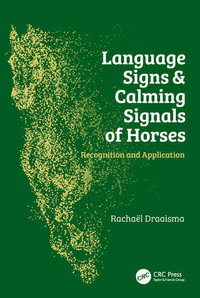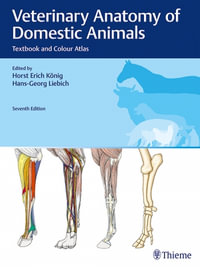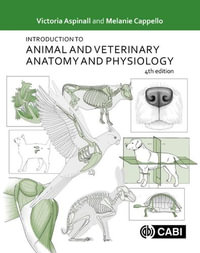
At a Glance
186 Pages
25.4 x 18.42 x 1.27
Hardcover
RRP $504.00
$356.75
29%OFF
or 4 interest-free payments of $89.19 with
orAims to ship in 7 to 10 business days
Lusi and Davies have provided an excellent reference resource for students and graduates alike. The number of well-defined, relevant and clear images allow quick understanding for anyone interested in the fascial anatomy of the horse. This small book is perfect to have in your bag, allowing the student or clinician to find all the information they need on-site. - Sophie Neasham, final year veterinary student, University of Veterinary Medicine in Kosice, Slovakia
Key features:
-
The first book in equine anatomy to illustrate the fascial (soft connective tissue) connections of the equine forelimb.
-
Clear, high-quality images (with reference images included on each page) help readers identify aspects of the limb photographed.
-
A brief introduction to the forelimb musculoskeletal anatomy (with images) helps readers familiarize themselves with muscles and bones portrayed in photographs.
-
Focused discussions highlight the practical applicability of the fascial connections illustrated.
-
Accompanying video clips demonstrate connectivity of the fascial system particular lines of tension.
The first of its kind in equine anatomy, this clear, concise anatomical guide illustrates the fascial (soft connective tissue) connections of the equine forelimb. Based on dissections of fresh equine cadaver limbs, it provides a visual map for equine physical therapists, veterinarians and horse riders, helping them to understand how pathologies, injuries, or movement abnormalities of the equine forelimb arise and/or progress from one area of the limb to another.
The fascial system is one of the primary systems acted upon by equine physiotherapists and is of increasing interest to horse riders looking to achieve structural integration and balanced movement in their horse. With this in mind, key points in each chapter highlight everyday situations in which knowledge of the fascial system may assist in understanding horse movement and injury.
This practically applicable anatomical atlas is the ideal reference for horse owners, body workers and veterinarians alike.
Industry Reviews
Fascial Anatomy of the Equine Forelimb is a concise book of only 186 pages, filled with numerous relevant and recent images clearly showing the equine fascial anatomy in the forelimb, backed up with informative text to describe the images, allowing identification of all the structures for even a novice anatomist. It is a small light-weight book, with dimensions of only 17.8 x 1.4 x 24.8cm, allowing the book to be easily transported in a handbag or backpack to where-ever needed, whether that be a lecture or practical.
The book begins with a brief overview of the general musculoskeletal anatomy of the forelimb, and is heavily supplemented with images, to acquaint the reader of the general area before going into more in depth, complicated structures, i.e. the fascia. In subsequent chapters, the authors have then gone into more detail for each fascial structure in the forelimb, starting at the bottom of the leg, with the digit and metacarpus, and making their way up to the shoulder girdle.
The images in the book were obtained during dissections of fresh equine cadaver limbs. They are very clear and each structure is labelled to increase reader understanding. Furthermore, each image is reflected and explained in the text. Due to the vast number of images, this book is very easy to follow and understand, and would be ideal for a student wanting to go into more depth with their equine anatomical studies, and also qualified veterinarians allowing a greater understanding for how the normal fascia should look and function, and how it is affected by pathology, injuries and other abnormalities of the equine forelimb.
In addition, the authors have made the text understandable allowing it to appeal to others in the industry, for example, equine physiotherapists or even horse-owners and riders wishing to increase their knowledge about their horse and any potential injuries or abnormalities they may have suffered. I do not believe the book goes into enough detail to provide a well-rounded education on the anatomy, structure and function of the fascial system of the forelimb, and for this purpose would have to be supplemented by another textbook. However, it is a great reference book, allowing readers to quickly research a structure. It has a very well-structured contents page, allowing quick reference for anyone who needs it.
In conclusion, Lusi and Davies have provided an excellent reference resource for students and graduates alike. The number of well-defined, relevant and clear images allow quick understanding for anyone interested in the fascial anatomy of the horse. This small book is perfect to have in your handbag, without causing back-problems, allowing the student or clinician to find all the information they need on-site.
- Sophie Neasham, final year veterinary student, University of Veterinary Medicine in Kosice, Slovakia
Fascial Anatomy of the Equine Forelimb is a concise book of only 186 pages, filled with numerous relevant and recent images clearly showing the equine fascial anatomy in the forelimb, backed up with informative text to describe the images, allowing identification of all the structures for even a novice anatomist. It is a small light-weight book, with dimensions of only 17.8 x 1.4 x 24.8cm, allowing the book to be easily transported in a handbag or backpack to where-ever needed, whether that be a lecture or practical.
The book begins with a brief overview of the general musculoskeletal anatomy of the forelimb, and is heavily supplemented with images, to acquaint the reader of the general area before going into more in depth, complicated structures, i.e. the fascia. In subsequent chapters, the authors have then gone into more detail for each fascial structure in the forelimb, starting at the bottom of the leg, with the digit and metacarpus, and making their way up to the shoulder girdle.
The images in the book were obtained during dissections of fresh equine cadaver limbs. They are very clear and each structure is labelled to increase reader understanding. Furthermore, each image is reflected and explained in the text. Due to the vast number of images, this book is very easy to follow and understand, and would be ideal for a student wanting to go into more depth with their equine anatomical studies, and also qualified veterinarians allowing a greater understanding for how the normal fascia should look and function, and how it is affected by pathology, injuries and other abnormalities of the equine forelimb.
In addition, the authors have made the text understandable allowing it to appeal to others in the industry, for example, equine physiotherapists or even horse-owners and riders wishing to increase their knowledge about their horse and any potential injuries or abnormalities they may have suffered. I do not believe the book goes into enough detail to provide a well-rounded education on the anatomy, structure and function of the fascial system of the forelimb, and for this purpose would have to be supplemented by another textbook. However, it is a great reference book, allowing readers to quickly research a structure. It has a very well-structured contents page, allowing quick reference for anyone who needs it.
In conclusion, Lusi and Davies have provided an excellent reference resource for students and graduates alike. The number of well-defined, relevant and clear images allow quick understanding for anyone interested in the fascial anatomy of the horse. This small book is perfect to have in your handbag, without causing back-problems, allowing the student or clinician to find all the information they need on-site.
- Sophie Neasham, final year veterinary student, University of Veterinary Medicine in Kosice, Slovakia
ISBN: 9780815387442
ISBN-10: 081538744X
Series: Vaccine Research and Developments
Published: 21st June 2018
Format: Hardcover
Language: English
Number of Pages: 186
Audience: Professional and Scholarly
Publisher: Taylor & Francis Inc
Country of Publication: US
Dimensions (cm): 25.4 x 18.42 x 1.27
Weight (kg): 0.64
Shipping
| Standard Shipping | Express Shipping | |
|---|---|---|
| Metro postcodes: | $9.99 | $14.95 |
| Regional postcodes: | $9.99 | $14.95 |
| Rural postcodes: | $9.99 | $14.95 |
How to return your order
At Booktopia, we offer hassle-free returns in accordance with our returns policy. If you wish to return an item, please get in touch with Booktopia Customer Care.
Additional postage charges may be applicable.
Defective items
If there is a problem with any of the items received for your order then the Booktopia Customer Care team is ready to assist you.
For more info please visit our Help Centre.























